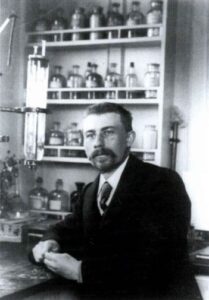The Danish Pioneer

The first mention of the development of a submersible measuring instrument with temperature and conductivity sensors dates back to the end of the 19th century and is associated with the name of the great Danish scientist Martin Knudsen. In 1898, the Commission for Scientific Investigation of the Danish Waters invited Martin Knudsen to develop a method for measuring the temperature and salinity of seawater in situ. He fulfilled this request by developing an instrument that made it possible to determine the salinity and temperature of seawater without collecting water samples or removing the thermometer from the water (Knudsen, 1900). To measure temperature he decided to use an electrolyte (KCl) because of its great temperature coefficient, compared to metals. The electrolyte was contained in a small vessel of such a form, that would rapidly assume the temperature of surroundings. That unique approach, when electrolytic conductance becomes the measure of temperature in reverse order of the modern approach of using temperature to correct the temperature dependence of conductivity, reflects a non-ordinary way of the genius of Knudsen in conditions of very limited technical means of the end of 19th century. In my experience of the development of the salinometer SOKOL, we used the same principle to derive the temperature of the measuring cell through the conductivity ratio of the reference conductivity cell, filled with standard seawater, by reversing the PSS-78 equation of the temperature dependence of standard seawater (rt). For the determination of the conductivity of the seawater, Knudsen used a vessel through which the water could move freely when lowered.

The vessel was connected to the Wheatstone bridge on board by means of cables. The conductivity was measured during the descending of the instrument (downcast), the temperature during the ascending (upcast). The instrument was calibrated by titration of the water sample and by use of the reversing thermometers. Though the method aroused considerable interest, it did not really come into use. There apparently were technical difficulties, for instance, with regard to compensation for capacity and energy loss in the cable between the submerged part of the apparatus and the shipboard instrumentation (Smed, 2002).
Some years late Knudsen’s experiments aroused considerable interest in England. After WWI, the British Navy realized that for submarine navigation detailed information about water layers was important. To discuss this matter, a small conference on submarine oceanography was held on 10 March 1920, where was suggested that Knudsen be contacted on the measurements of salinity and density by electrical conductivity. Later was stated that according to recent communication from Prof. Knudsen this method had special application at sea since a large number of observations could be taken concurrently of salinity and temperature during the hauling the apparatus from the bottom, the observations being recorded in the ship’s laboratory. It was suggested to attempt a simplification of the Knudsen’s apparatus and to undertake a series of experiments to determine the accuracy of the method. It was considered possible on a cruise to obtain salinities to, say, 0.05% within some five minutes after reaching the stratum investigated (Smed,2002).





 Visit Today : 433
Visit Today : 433 Visit Yesterday : 634
Visit Yesterday : 634 This Month : 7445
This Month : 7445 Total Visit : 291292
Total Visit : 291292 Hits Today : 479
Hits Today : 479 Total Hits : 702620
Total Hits : 702620 Who's Online : 2
Who's Online : 2